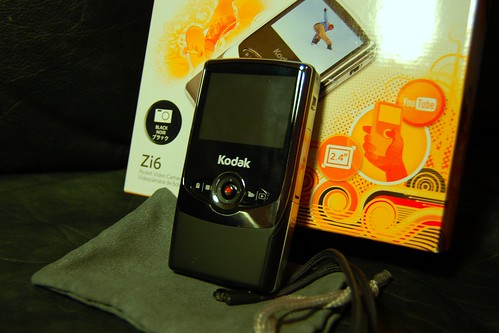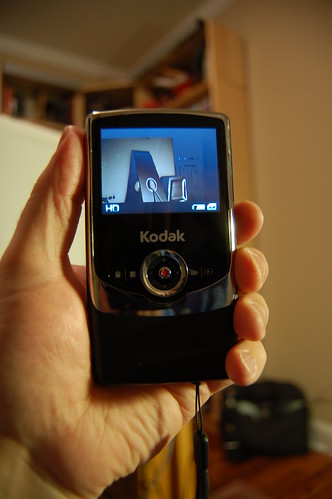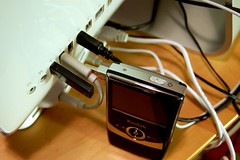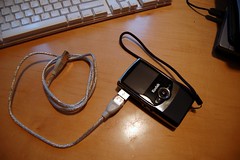So, as part of one of my goals for 2009, we’re starting to shoot more video (mostly of Ainsley, natch). We’ve done so in the past, but with not with any regularity. Though one cannot ignore the fact of lazy parenting, I do think there are other more significant issues contributing to our lack of shooting video around here.

The Kodak Zi6 mounted on the plenty hefty Gorillapod
I think it is much more the issue of the technology in question. Our little Canon ZR200 DV camcorder didn’t shoot very high quality video, and it was even poorer when recorded onto an SD card. The process of uploading DV video into iMovie is cumbersome, as the video has to be recorded in real-time from the camera’s playback head. Lastly, despite being relatively small for a camcorder, it is still a large device when compared to a pocket digital camera or even a cell phone — many of which now record video as good as our camcorder.
Let me compare to the nearest medium I can: photography. When we first got a large storage card for our first digital pocket camera, it began to open a world of new uses for that device. Photos were no longer reserved for the must-document moments of a vacation or holiday. They could be used to document anything worth noting. We could practice photos without worry about filling the storage (or development costs, etc.). We began to use photos as visual communication. For example, I could take some photos of some plumbing fixture and show the sales-staff at the local hardware store right from the camera, giving them a much better description of what I needed than my limited plumbing knowledge could describe. I know first hand how digital photos have revolutionized the construction industry in terms of inspections and communication. It’s the economy of free1 come to photography.
A small size also affects how a camera is used. When a camera becomes small enough to be packed into another device — like, say, a cell phone — it’s use changes. Think what the cell phone camera has done for the number of snapshots in the world. I would venture that party or self-portrait snapshots have increased by an order of magnitude due to the ubiquity of small (albeit rather shitty) cameras in the world. Why? Because they’re so small as they can always be on hand. They’re stuck into another device. Even when a camera is still just a camera, if it is sufficiently small someone can easily carry it almost all the time.
With the large storage capacity combined with a very small size, the pocket digital camera becomes a different tool altogether than a small camera with limited storage or a large camera2. I think that having a digital HD video camera that is essentially the same size with an fairly large capacity — say, several hours — equally transforms what a video camera can be used for.
So, I decided to start looking into the purchase of a digital HD video camera.
Features That Appealed to Me
There are now a few options in the (relatively) new class of pocket HD video cameras3. The Zi6 sells along side the similar form-factor Flip MinoHD, as well as a few other solid-state HD cameras with the flip-out lcd screen form-factor. So, why did I decide on the Kodak?
If it had come down to pure good looks, I’d have gone with the Mino. It has a slightly smaller footprint and sleeker looks. However, it lacks a number of features that make the Zi6 the winning option, in my opinion.
The Zi6 does have some on-board memory. About enough for 2–3 minutes of video, I think. It does, however, also use SD cards for extended memory. As we have piles of 1 and 2GB SD cards lying around (it has become the preferred flash storage medium in our household), it was a logical choice to extend their usefulness. Secondly, the Zi6 uses a pair of AA batteries for power. It actually comes with a pair of rechargeable batteries and charger, which is a nice include. Anyone who has ever drained their camera battery only to realize that the charger or cable was left at home knows that sinking feeling of hold a high-tech paperweight. It’s a rare place in our lives that is more than 5 minutes and $3 from a pair of AAs. Not to mention, we own a pile of rechargeable AAs as well4. So, the Zi6 certainly was a better choice to leverage what we already own. Further, the Zi6 has a much larger screen than the Mino. As this is the only view of what you are recording (no view finder on something this small) and it is handy for playback, this also was a big bonus. Lastly, and this cannot be overlooked, the Zi6 is about $50 less than the Mino.
So, Zi6 FTW.
Downsides
I was a bit disappointed by the feel of the device. Though the fit and finish is high quality, the device feels light and plasticy — as though it could crack open with a drop to the ground. I would have like to have seen this device with a more substantial case around it. What looks like metal trim is, in fact, chromed plastic 5However, this is just an impression and it is only fair to point out that nothing has happened to the case in my use thus far.
Also, the quality of the picture is far-from perfect. First, there is a lot of noise in the images. Given that this has been my biggest complaint about my Nikon D50, I suspect this is going to annoy me. But, with more pixels to work with, the adjustments to picture in post-processing can better improve the end product. Also, the camera’s speed is fairly slow6. That is, motion can get really blurry. If my toddler can become a blur of motion, there’s little hope of using this camera to record anything very fast. Also, as you might expect given a camera that weighs less than 6 oz. (and there fore has very low moment of inertia compared to me), the picture can be a bit shaky. Lastly, the low-light sensitivity seems almost non-existent. We won’t be shooting any horror films on this one; or, at least, if we do it will be those awful scenes where there’s just screaming and you can’t make out anything that is happening. The color balance seems to swing pretty wide between blues and yellows, as well. This camera needs even lighting, and quite a lot of it, it would seem.
All that being said: let’s be fair. This is a $150 device that shoots 1280x720 video and, with a $40 card, can store up to eight hours of video at that resolution7. Also, the Zi6 also has a female threaded mount on the bottom, which of course could go a long way to reducing shakiness — either by using a tripod or my $14 steadycam. There is, not surprisingly, no hot shoe for attaching a light or external mic on the Zi6. However, there wasn’t one on our Canon ZR200, either, and that was a let down. Keep in mind, even though it was a cheap camcorder, it was twice the price of the Zi6.
Using the Camera
The device’s size is terrific. It is almost exactly the size of two first-gen iPhones stacked together (that is, same footprint; just twice as thick). I know this because I stacked Angela’s and my iPhones together for comparison.
This includes (as does the competing Flip HD) the swing out USB connector. This is a bit bigger than the Mino HD, but at the trade of a much larger screen. However, it still feels good in my hand and Angela seemed to agree.
Of course, even if the thing was half as thick, it would still be a bit of a pain to actually use the flip-out USB connector to plug it into the back of my iMac. It is about the right height, but those ports are very close together (a USB jump drive is a tight fit).
However, I also happen to have one of the handiest USB devices around — which isn’t really a device at all. It’s a 1 meter USB cable extension cable. I happened to get this relatively short one along with a legacy serial port to USB adapter I purchased some time ago. However, there are plenty of cheap cables available at Amazon.
There is a disc included with some Windows software for transferring (and maybe editing?) files. Of course, there isn’t any mac software included. But, as I’ve never cared for pack-in software that comes with any camera I’ve ever owned, I really wasn’t planning on installing anything anyway. The included software apparently has some links to quick upload the video straight to YouTube, but I’m not really going to miss that8. Pretty much any computer sees the Zi6 as a USB mass storage device, with the files in sub-folders (just like a digital camera). The files are in Quicktime (.mov) format. Given that every mac comes with Quicktime and iMovie, using them on a mac is actually easier than on a Windows PC. The files are roughly 1MB per second of video (on the 30 frames per second setting), which puts a 2GB card holding approximately 30 minutes of video. Therefore, the maximum video on a single 32GB card is a little over 9 hours. That’s not too bad considering that would be 9 miniDV tapes plus the camera for a typical camcorder.
Our First Zi6 Movie from Jason Coleman on Vimeo.
Currently, we have a very old version of iMovie and it is simply not letting me output the video in its full quality (despite selecting “full quality”, or even the 1280x720 option). So, the best output I could get that reasonably displayed some of the first video we shot is above; hosted on Vimeo. As soon as iLife ’09 is released, I’ll see about re-posting the video for comparison. In the meantime, check out some of the footage shot on a Zi6 at Vimeo or Flickr to see what this little camera is capable of.
So far, we’ve been very pleased.
- How a tool, device, or service gets used drastically changes when its cost drops to essentially nothing. Read Chris Anderson’s — Sr. Editor at Wired — article for a more in depth look at the economy of free. [↩]
- After having a DSLR for over two years now, I can tell you that there are some situations that such a large camera just isn’t well suited for. Not that it can’t be used, mind you. Just that the size makes it more awkward and, therefore, less likely to be used in the first place. [↩]
- And no doubt many more now, as CES just wrapped up. [↩]
- We have the Energizer rechargeable batteries with the 15-minute charger
and have been very happy with them thus far. We use them mostly for Wii remotes and they’ve lasted for over two years now, though it does seem that they don’t hold as long of a charge as the initially did. I’ve also heard good things about the Sanyo eneloop batteries
, but haven’t tried them myself. [↩]
- Gee, I hope it doesn’t wear off to that yellow plastic like all of my Transformers did when I was a kid… Am I the only person who notice that? Apparently not. [↩]
- It may be possible that using a SD card with a faster write speed may help this, but I’m not sure that is the limiting factor here. [↩]
- This is based on the 60 minutes of video for a 2GB card base. The camera can use up to a 32GB SD card. However, given that those currently cost around $130+, I don’t see that as being really practical. After all, it’s not like SD cards really take up much space in your pocket and last I checked 4x16 was greater than 32; at current prices
. [↩]
- Frankly, the jerks who uploads un-edited video straight to YouTube — video that isn’t of a breaking news event — only hurt us all. Let’s all hope for more editing on sites like YouTube. [↩]




You can never go wrong with Sanyo Eneloop batteries, they have very low self-discharge rate and it is a bang for the product.‘-: